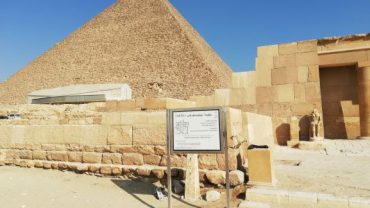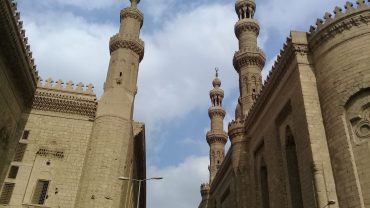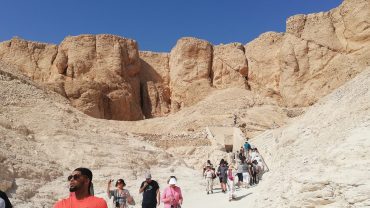Temples of Abu Simbel are considered among the most celebrated achievements of the ancient Egyptians. The two temples were cut in the cliffs about 250 km south of Aswan. The temples were excavated by Belzoni in 1917 when the two temples were buried in the sand. The two temples were built by Ramesses 2nd, while he dedicated the small temple to his wife Nefertari; both temples are unique in their design as well as their construction.
The great temple
The façade of the temple was built imitating a pylon, about 30 m. high and 40 m. wide.
Four colossi of Ramesses 2nd are decorating the façade, each about 20 m. high; around the legs of Ramesses 2nd are some of his wives, sons, and daughters. The first statue on the left-hand side is destroyed and we can’t say when and how it was damaged. On the two sides of the throne of the statues flanking the entrance, are figures of the enemies of Egypt (Nubians and Asians) presented as captives kneeling under the feet of Ramesses 2nd and also the figures of the Nile god Hapi tying the papyrus and the lotus flowers around the trachea of Osiris, the symbol of unification.
The statue to the left side on his left leg, there is a Greek inscription dating to the time of king Psimatiqu 2nd of the twenty-sixth dynasty.
Above the statues, there is a group of baboons with raised hands greeting the sun. Exactly in the middle above the entrance, there is the statue of god Ra horakhty one of the gods to whom the temple is being dedicated.
In front of the temple, there are some statues of the king and the falcon god Horus.
As well as on the left-hand side of the temple there is a famous stela carved in the rock showing Ramesses 2nd with the Hititi king and his daughter and the document is giving us the news of Ramesses 2nd‘s marriage to the Hititi princess.
So the temple is 180 ft. long and all hewn in the rock.
The first hypostyle hall
It is about 18 m. wide and 19.5 m. long. On both sides of the hypostyle hall, there are 8 pillars in two rows. On the pillars, there are 8 statues of Ramesses 2nd facing each other represented in the Osiron form. The other sides of the pillars are representations of Ramesses 2nd while giving offerings to some Egyptian gods. The ceiling is decorated with the figures of the vultures.
The scenes on the walls of the hypostyle hall are very important
On the extreme right side of the entrance are scenes showing Ramesses 2nd smashing the heads of his enemies in front of god Ra horakhty. On the right wall, there are some scenes showing some parts from the battle of Kadash, Ramesses 2nd is represented with his army in their camp in Syria and during his attack against the Hitites.
On the extreme left side of the entrance are the same scenes showing Ramesses 2nd punishing his enemies in front of the god Amon re. On the left side of the hypostyle hall, there are also some military scenes showing Ramesses 2nd while attacking a fortress and driving some captives to god Amon re.
On the left side between the third and the fourth pillars, there is a table dating to the thirty-fifth years of Ramesses 2nd‘s reign telling us that the king built a temple in Memphis and dedicated it to god Ptah.
In the right wall of the hypostyle hall, there are two doors leading to two rooms. The rooms are decorated with ordinary scenes showing the king giving offerings to the Egyptian gods.
In the rear wall of the hypostyle hall, there are three doors, the doors on the two sides are leading to six side chambers decorated also by religious scenes, while the door in the middle is leading to the second hypostyle hall.
The second hypostyle hall.
It is smaller than the first hall. It is 12 m. long and 8 m. wide. It has four pillars decorated by scenes the king embraced by some Egyptian gods.
The left side is showing the king while offering to god Amon re, goddess Mut and god Khonsu, also burning incense in front of the sacred bark of Amon re while his wife Nefertiri standing behind him. There are repeated on the right side except that Ramesses 2nd is offering to god Ra horakhty and god Min.
The vestibule
Another door in the rear wall of the second hypostyle hall leads to a vestibule also decorated by religious scenes showing Ramesses’ 2nd offering to the Egyptian gods. There are three doors in the rear wall of the vestibule; the sides are leading to two undecorated rooms, while the middle door leads to the sanctuary.
The sanctuary
In the sanctuary, there is the broken stand of the sacred and also an altar in the middle. In the end, there are the four statues of Ra horakhty, Ramsses 2nd, Amon Re, and Ptah. On the twenty-second of February and twenty-second of October which are the occasions of the king Ramesses 2nd‘s coronation day and birthday, the sun would shine all the way from the entrance directly on the faces of the statues except the statue of Ptah because he was the god of darkness.




Comment (0)